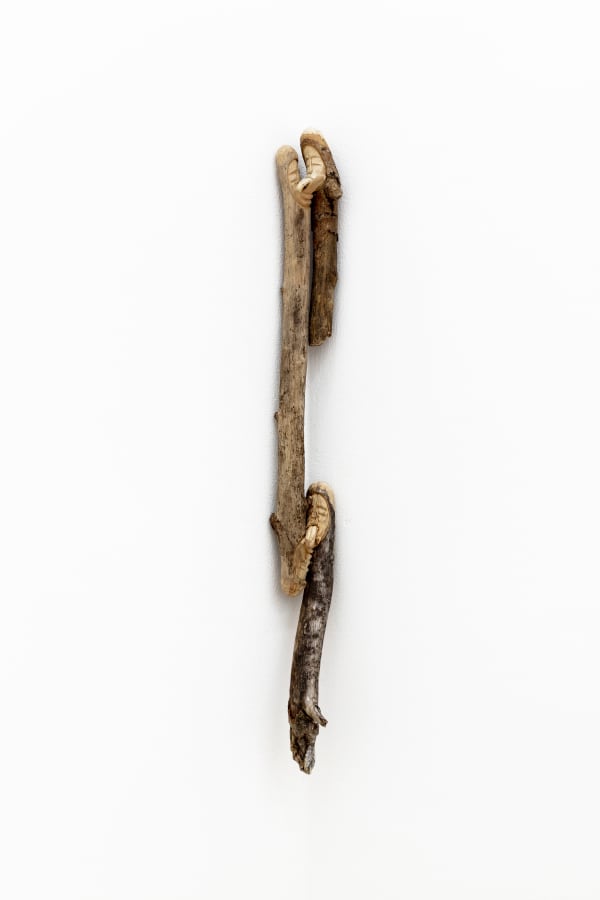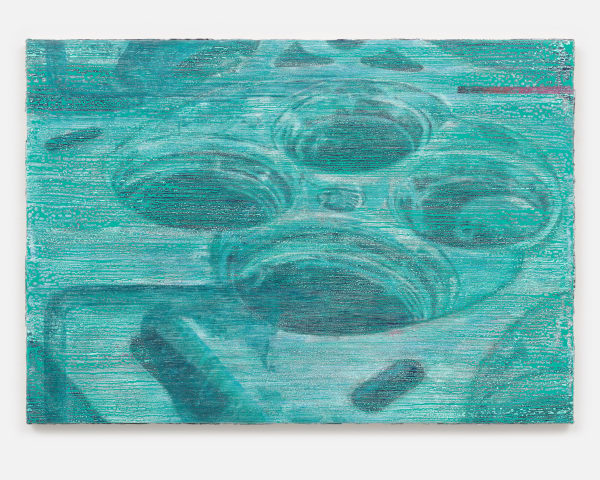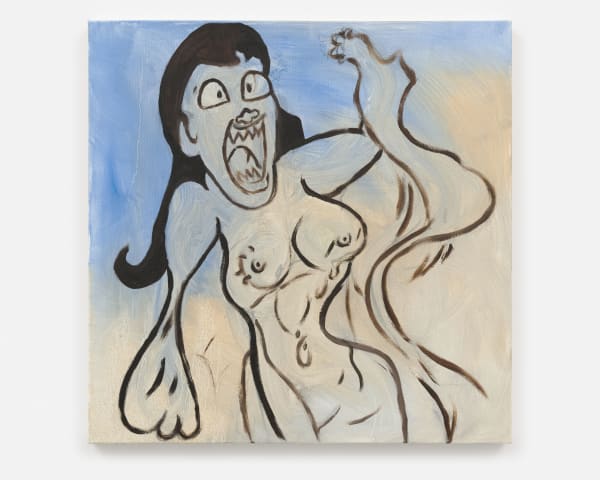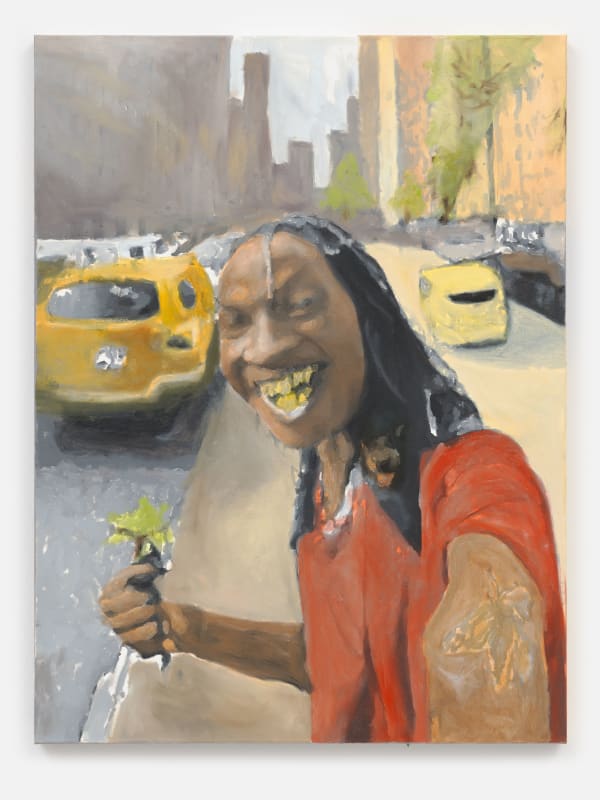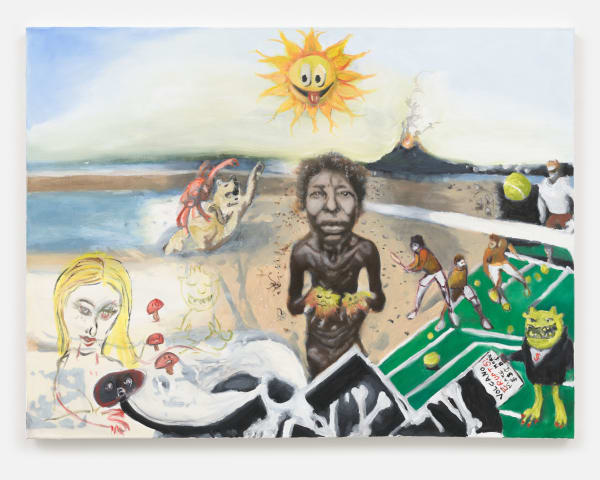Of Orchids and Wasps: ALEXANDER CARVER, TAÍNA CRUZ, BRETT GINSBURG, BIRKE GORM, URSULA SCHULTZE-BLUHM, ROSARIO ZORRAQUÍN
-
 Of Orchids and Wasps, exhibition view, Kraupa–Tuskany Zeidler, Berlin, 2023
Of Orchids and Wasps, exhibition view, Kraupa–Tuskany Zeidler, Berlin, 2023 -
 Of Orchids and Wasps, exhibition view, Kraupa–Tuskany Zeidler, Berlin, 2023
Of Orchids and Wasps, exhibition view, Kraupa–Tuskany Zeidler, Berlin, 2023 -
 Of Orchids and Wasps, exhibition view, Kraupa–Tuskany Zeidler, Berlin, 2023
Of Orchids and Wasps, exhibition view, Kraupa–Tuskany Zeidler, Berlin, 2023 -
 Of Orchids and Wasps, exhibition view, Kraupa–Tuskany Zeidler, Berlin, 2023
Of Orchids and Wasps, exhibition view, Kraupa–Tuskany Zeidler, Berlin, 2023 -
 Of Orchids and Wasps, exhibition view, Kraupa–Tuskany Zeidler, Berlin, 2023
Of Orchids and Wasps, exhibition view, Kraupa–Tuskany Zeidler, Berlin, 2023 -
 Of Orchids and Wasps, exhibition view, Kraupa–Tuskany Zeidler, Berlin, 2023
Of Orchids and Wasps, exhibition view, Kraupa–Tuskany Zeidler, Berlin, 2023 -
 Of Orchids and Wasps, exhibition view, Kraupa–Tuskany Zeidler, Berlin, 2023
Of Orchids and Wasps, exhibition view, Kraupa–Tuskany Zeidler, Berlin, 2023 -
 Of Orchids and Wasps, exhibition view, Kraupa–Tuskany Zeidler, Berlin, 2023
Of Orchids and Wasps, exhibition view, Kraupa–Tuskany Zeidler, Berlin, 2023
-
 Ursula Schultze-Bluhm, Liebe Carlota, 1961
Ursula Schultze-Bluhm, Liebe Carlota, 1961 -
 Ursula Schultze-Bluhm, Rendez-Vous, 1986
Ursula Schultze-Bluhm, Rendez-Vous, 1986 -
 Ursula Schultze-Bluhm, Spinne für Bär am 31. Mai 1990, 1991
Ursula Schultze-Bluhm, Spinne für Bär am 31. Mai 1990, 1991 -
 Rosario Zorraquín, Margarite, 2020
Rosario Zorraquín, Margarite, 2020 -
 Rosario Zorraquín, Puente, 2020
Rosario Zorraquín, Puente, 2020 -
 Birke Gorm, IOU, 2021
Birke Gorm, IOU, 2021 -
 Birke Gorm, IOU, 2021
Birke Gorm, IOU, 2021 -
 Birke Gorm, IOU, 2021
Birke Gorm, IOU, 2021 -
 Birke Gorm, I CAN SMILE AT THE PAST no. 11 (The Pagan Woman), 2022
Birke Gorm, I CAN SMILE AT THE PAST no. 11 (The Pagan Woman), 2022 -
 Brett Ginsburg, Coterie of Misfires, 2023
Brett Ginsburg, Coterie of Misfires, 2023 -
 Brett Ginsburg, Single Surface Code, 2023
Brett Ginsburg, Single Surface Code, 2023 -
 Alexander Carver, The Spinning Wheel (Ribboned Flesh), 2023
Alexander Carver, The Spinning Wheel (Ribboned Flesh), 2023 -
 Alex Carver, Flaying Knife I (Human), 2023
Alex Carver, Flaying Knife I (Human), 2023 -
 Alexander Carver, Flaying Knife II (Dog), 2023
Alexander Carver, Flaying Knife II (Dog), 2023 -
 Taína Cruz, Let's save lives, 2023
Taína Cruz, Let's save lives, 2023 -
 Taína Cruz, Look'ere I picked this up on 125th, 2023
Taína Cruz, Look'ere I picked this up on 125th, 2023 -
 Taína Cruz, Mind Map 2023: Wake up call, 2023
Taína Cruz, Mind Map 2023: Wake up call, 2023 -
 Taína Cruz, Stay a little longer, 2023
Taína Cruz, Stay a little longer, 2023
Of Orchids and Wasps presents works by Alexander Carver, Taína Cruz, Brett Ginsburg, Birke Gorm, Ursula Schulze-Bluhm and Rosario Zorraquín that explore various perceptions of materiality, spirituality and technology, the entanglement of the mechanical and the natural, transcending and frolicking, labor and humor. By creating a web of content, each position links to the others in a subtle complexity, allowing for a multiplicity of approaches and entry points. The works form tangible material narratives that hold equal significance as artistic discourse and exhibition making.
One of Brett Ginsburg’s conceptual curiosities is entomology, and the influence that evolutionary biology has on the development of technology. Ginsburg’s paintings reject a binary classification of the natural world and machinery as polarizing entities, instead emphasizing their enmeshment. Single Surface Code, 2023 can be read as a cryptic mix of machinery and the biological impetus which has informed industrial development. Although the polished and refined surfaces of Brett Ginsburg's paintings, which are, contrary to their appearance, hand painted, may conflict with Birke Gorm's use of organic materials, their works are complementary explorations of industrialized labor. While Ginsburg approaches the subject matter from a technical and mechanical standpoint, Gorm's employment of natural material offers a similar artistic examination of the same theme. The adjacency of the works in space divulge and reinforce the industrial application of these materials— IOU, 2021 and I CAN SMILE AT THE PAST no.11 (The Pagan Woman), 2022 by Birke Gorm appears folkloric and mischievous, yet simultaneously refer to an era in which its materials, jute, wood and burlap, had an industrial application.
Carver’s paintings on this elaborate web of meshed content, offer a perspective on the passage of time and its effect on industrialized society, as in The Spinning Wheel (Ribboned Flesh), 2023 a human is victimized by a breaking wheel. Carver’s concurrent use of analogue methods such as frottage, and the digital aesthetic of the pixelated texture which punctuate the painting’s surface, produces transhistorical imagery. His painterly process is deeply self analyzed and inspected, as he treats the canvas as a membrane, as does Rosario Zorraquín, whose mystical paintings, at first glance, seem antithetical to Carver’s contorted depictions of figures. Zorraquín treats the linen gauze onto which she paints as skin, subjecting it to a series of rites of portraying, she conducts the readings which precede her painting. The fabric is wrapped around the subjects of her mores, and doused in water before being painted and drawn on, often written on in the language she has developed over the course of her liturgical practice, the Glosario. The fabric, as if it were a skin which carries scars and memories of its body’s experience, is embedded with the revelations of shamanistic rituals. Margarite, 2020, represents the corporeal and mystical poles of Zorraquín’s practice. Her readings, which are a social practice in addition to being foundational to the creation of her paintings, formulate the translation of a physical body onto the fabric. Zorraquín traces and marks upon the individual, enclosed in the thin membrane of the linen gauze. As such, the painting’s indexical relationship to the body is established, and furthermore, the readings, in which she asks the subject to name the work, creates space for fiction. In the case of Margarite, the title of the work was the namesake of a beloved character from a book.
Ursula Schulze-Bluhm’s drawings are mystical, as she, as a writer and poet, crafts elaborate depictions of nature which serve as allegories for the body. Ursula’s surreal and psychedelic works act as portals to worlds she has built, inventing new mythology. In Mind Map 2023: Wake up call, 2023 Taína Cruz engages with fantasy and world building also, as her highly narrative practice is both fantastical and rooted in the real world. Cruz’s tableau of mystical creatures. Mind Map 2023: Wake up call abounds with content, the central figure is surrounded by both disjointed and interrelated scenes: a monstrous caricature of a capitalist holds a memo referencing the volcanic eruption in the horizon of the painting. The episodes within this work follow a concentric logic on the canvas, hence Cruz’s propensity towards non-linear narrative storytelling. Cruz’s environments are an amalgamation of
her personal contexts, and thus the works host the atmosphere of New York streets in Look'ere I picked this up on 125th, 2023, as well as contemporary artistic translation of ritualistic culture in others. As she is informed by the internet’s pictorial culture, her works collapse time and compile visual references, stripped from their initial context and recontextualized within Cruz’s imagined environments.
'The orchid and the wasp constitute one of these virtualities, two autonomous series that intersect on a line of flight, a rhizome that engenders two distinct becomings and carries their singularities to a threshold of intensity where they merge.’ A Thousand Plateaus’ (1980), by Gilles Deleuze and Félix Guattari, Introduction: Rhizome
The figure of the Orchid and the Wasp is used by Deleuze and Guattari to explore interrelated concepts, such as the rhizome. The rhizome is distinguished by its cross-connections and serves as an alternative to conventional, uniform approaches to curation and academia, aimed at promoting a reconfiguring way of thinking. The intricate and specialized interdependence of Drakae Orchids and Thynnid Wasps¹, serves as a paradigm for biological coevolution and symbiosis. The two species share a mutually beneficial and ever-changing relationship that defies rigid boundaries and fixed classifications. By linking together, they underscore the importance of fluidity and perpetual metamorphosis in their partnership, hence diversity and collaboration. By adopting the rhizome as a framework of thought, Of Orchids and Wasps employs a kaleidoscopic, dialogic, and queer methodological approach, which shifts away the focus from chronology and synchronicity. The exhibition offers multiple signifying nodes that allow for a manifold of possible connections between the different artistic practices, underlining the multifaceted character of each specimen in the show.
ALEXANDER CARVER (b. 1984, Boise, Idaho) lives and works in Boise, Idaho. Alexander Carver’s kaleidoscopic paintings deal with architectures of pleasure and discipline. Carver’s application of techniques such as frottage produce dense and multilayered compositions, able to warp space and time. Carver is a graduate of Cooper Union, New York and received his Masters of Fine Arts from Columbia University, New York. His work has been exhibited and screened in international venues and in festivals including Stavanger Art Museum (2023); the Art Encounters Biennial, Romania (2021); Kraupa-Tuskany Zeidler, Berlin (2021, solo); Helena Anrather, New York (2021,solo); Miguel Abreu Gallery, New York (2019,solo); Tate Modern (2018); Kraupa-Tuskany Zeidler, Berlin (2018); Lincoln Center, New York (2016); Berlinale, Berlin (2015); Biennale of Moving Image, Geneva (2014); Melbourne International Film Festival, Melbourne (2014); BAM, New York (2014); Locarno International Film Festival, Locarno (2013); Vancouver International Film Festival, Vancouver (2013).
TAíNA CRUZ (b. 1998, New York) is an archivist, artist and researcher based in New York. Spanning 3D rendering, painting, and video, her work focuses on contemporary relationships with Indigenous American and West African material, ritual and visual culture. Cruz reconstructs geographic and digital spaces in her works, with imagery drawn from agriculture, graffiti, Tumblr and Dump FM, into which she places her (often) mystical characters. Recent exhibitions include Housing Gallery, New York (2022; solo); Embajada, Suan Juan (2022; solo); Housing Gallery, New York (2021); New Release Gallery, Online (2020); The Gormley Gallery, Baltimore, (2020). Cruz received the GO-A: Goya Opportunity Award, San Juan, Porto Rico (2019) and was featured on the MICA Dean's List 2016-2020, Baltimore, United States of America (2020).
BRETT GINSBURG (b. 1990, Kansas City, Missouri) lives and works in New Haven, Connecticut. He recently received an MFA in Painting/ Printmaking from Yale University (2022), attended the Saas-Fee Summer Institute of Art (2022), and received a BFA from the Kansas City Art Institute (2013). In his painterly practice Brett Ginsburg responds to the vibratory and unseen technical systems that proliferate our surroundings, engaging in the spatial navigation of infrastructural and ecological sites. He is a current participant in the Interdisciplinary Art and Theory Program in New York. Ginsburg completed a Research Fellowship at the Beinecke Rare Book & Manuscript Library, Yale University (2022). His work has been included in exhibitions at Jeffrey Deitch, New York (2022); Below Grand, New York (2022); Green Hall Gallery, New Haven (2022); The Bunker West, Malibu (2020) and the Museum of Arts and Design, New York (2014).
BIRKE GORM (b. 1986, Hamburg, Germany) lives and works in Vienna. Birke Gorm's practice is entrenched in the ethics and materiality of labor and production. Her sculpture and installation works reappropriate materials such as jute, burlap and wood— materials with a historically feminine and craft labor connotation, and which stand in stark opposition to the materiality of the modern industrialized world. Gorm completed her studies in painting at the University of Fine Arts in Hamburg in 2016 under the guidance of Jutta Koether. She pursued further studies at the Academy of Fine Arts in Vienna, where she was mentored by Monika Bonvicini, and received her degree in 2018. Her work has been shown at MAK Museum of Applied Arts, Vienna (2023, solo); Vestjyllands Kunstpavillon, Videbæk (2023); Federal Chancellery of Austria, Vienna (2023); Kunstraum Dornbirn (2022); mumok, Vienna (2022). She currently has a solo exhibition at MAK, Vienna.
URSULA SCHULTZE-BLUHM, known as Ursula, (b. 1921, Mittenwalde, Germany, d. 1999) lived and worked in Cologne until her death in 1999. Ursula was an artist and poet of the post-war avant-garde. In meticulous, small-scale drawings and paintings, the self-taught artist creates an independent oeuvre that can neither be clearly categorized as Art Brut or Outsider Art, nor as other currents of figurative post-war art. She began her intensive occupation with painting and poetry in 1950, followed by regular stays in Paris. She exhibited regularly in international museums and galleries, including documenta 6 in 1977. Her works are in the collections of National Gallery in Berlin, the Staatliche Kunstsammlungen Dresden, Hamburger Kunsthalle, the Museum für Moderne Kunst in Frankfurt am Main and the Musée National d'Art Moderne, Centre Pompidou in Paris, among others. The artistic estate has been divided between the Folkwang-Museumsverein and the Museum Ludwig in Cologne and is now managed by VAN HAM. The Museum Ludwig will present a comprehensive solo exhibition of Ursula’s work in 2023.
ROSARIO ZORRAQUíN (b. 1984 Buenos Aires, Argentina) lives and works in New York. Through an in-depth investigation involving experiments around language and the practice of recording human experience, Zorraquín seeks new spaces and synchronous worlds through her paintings and installations. Inspired by shamanism, magic, and psychoanalysis, the artist uses a self-made system of symbols to conduct rituals that verbalize the unvoiced thoughts of friends and strangers. Creating dialogues that become the inner-narratives of her diaphanous canvases, her work functions as a container, a portal, existing in a borderland. Zorraquín is the recipient of Kuitca Scholarship at Torcuato Di Tella University, Argentina (2010-2011) and graduated from National Institute of Visual Arts (IUNA), Argentina in 2008. She participated in residencies at the Banff Centre for Arts and Creativity in Alberta, Canada in 2012; FAAP (Fundação Armando Alvares Penteado) in São Paulo, Brazil in 2016; and PAF (Performing Arts Forum) in St. Erme, France in 2018. Her work has recently been exhibited at Revolver Gallery, New York (2022; solo); Galería Isla Flotante, Buenos Aires (2021; solo); art space, Buenos Aires (2019); Galería Selvanegra, Buenos Aires (2019; solo); ArteBA, Buenos Aires (2019; solo); MACLA, Buenos Aires (2019).
¹ In order to attract male wasps, the orchid displays physical and sensory characteristics of female wasps. As the wasps attempt to mate with the orchids, they inadvertently pick up and transfer pollen between flowers. This seduction ultimately results in the wasps being unwittingly integrated into the orchid's reproductive process.














